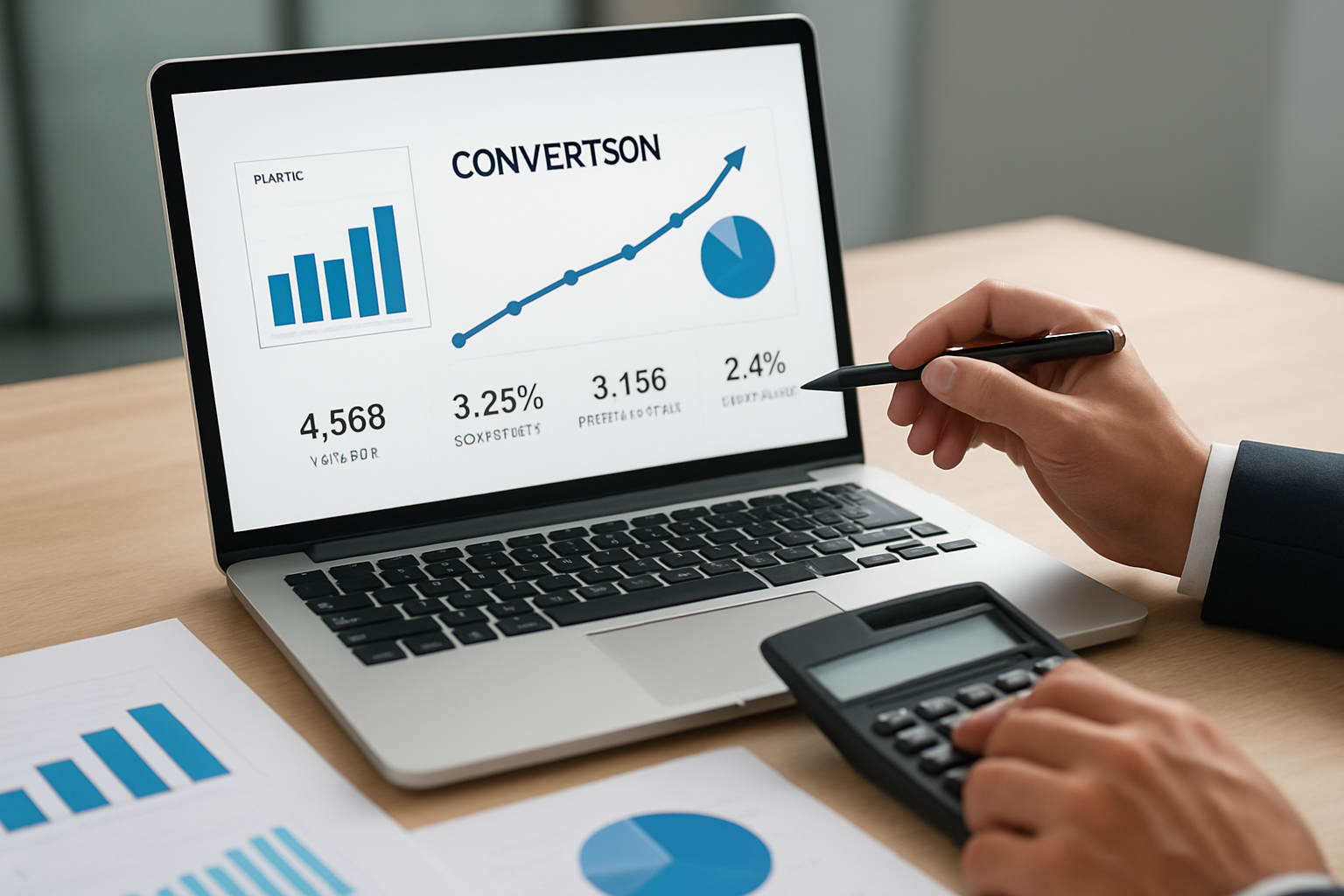Let’s talk about the elephant on your analytics dashboard. You are driving traffic, yet sales feel stuck in neutral, and you are not sure where the leaks are. That is exactly where conversion optimization shines, because the real game is not just more clicks but more customers. Think of it like an in-store experience online. You have the perfect location from great SEO (Search Engine Optimization) and PPC (Pay-Per-Click), but if the aisles are cluttered, the signs are confusing, and the checkout line feels endless, people walk out. The good news is most conversion roadblocks are fixable in days rather than months, and the fastest wins usually come from better messaging, faster pages, and less friction on mobile.
Conversion Optimization: What It Really Means Today
At its core, conversion optimization is about increasing the percentage of visitors who take a desired action, whether that is a purchase, a demo request, a booked appointment, or a newsletter sign up. The modern approach blends research, A/B (Split) testing, and customer empathy with sharp technical execution, and the compounding effect can be dramatic. For example, lifting a product page from 2 percent to 3 percent conversion can translate into 50 percent more orders without increasing ad spend, and that means better ROI (Return On Investment) from SEO (Search Engine Optimization) and PPC (Pay-Per-Click) together. Internetzone I sees this play out across industries, where small wins up funnel and down funnel stack into something that feels like magic, yet it is simply methodical improvement.
Here is the twist most teams miss. Conversion is not only a checkout or a form goal; it is a chain of micro conversions: searcher becomes visitor, visitor becomes engaged reader, reader becomes lead, lead becomes customer, and customer becomes advocate. Each step is influenced by speed, clarity, trust, and relevance to intent on both National & Local SEO (Search Engine Optimization) queries. When your funnel respects how humans decide, and your pages honor what users came to do, the data turns in your favor. That is why the most effective programs align UX (User Experience) and UI (User Interface), content, and technical performance with the same KPIs (Key Performance Indicators) your sales team actually cares about.
| Term | Plain Definition | Why It Matters |
|---|---|---|
| Macro Conversion | The primary goal like a sale or demo booking | Determines revenue and core ROI (Return On Investment) |
| Micro Conversion | Smaller steps like add to cart or video view | Signals intent and highlights where friction starts |
| A/B (Split) Test | Compare two versions to find a winner | Reduces guesswork and proves impact |
| UX (User Experience) | How easy and enjoyable a site feels | Drives engagement and trust to convert |
The 10 Silent Killers: Mistakes and Fixes You Can Apply This Week
-
Slow Pages, Slower Revenue
Every extra second of load time can hurt conversions by several percentage points according to industry studies, and mobile users bounce even faster. Run a quick check of Core Web Vitals in GA4 (Google Analytics 4) and aim for sub 2.5s LCP (Largest Contentful Paint), stable CLS (Cumulative Layout Shift), and responsive INP (Interaction to Next Paint). Compress images, lazy load below-the-fold assets, and serve next-gen formats to wring out waste without sacrificing quality. Internetzone I hardens performance by pairing SEO (Search Engine Optimization) best practices with lightweight, mobile responsive web design so your site feels instant on any connection.
-
Confusing or Generic Calls To Action
Buttons that say “Submit” are not persuasive, and vague microcopy breeds hesitation. Clarity beats cleverness when the user is deciding what happens next, so use action language and context like “Get My Free Quote” or “See Pricing” and reinforce it near value propositions. Test placement above the fold and after key benefits, and ensure your CTA (Call To Action) color contrasts pass accessibility checks. You will be surprised how quickly click-through improves when the next step is unmistakable.
-
Design That Looks Pretty but Fights the Sale
Beautiful does not always mean usable, and cluttered hero sections bury crucial proof. Studies show most users form a trust judgment in under a second, so lead with a tight headline, a concise subhead, and one primary action. Put social proof such as reviews and logos within the first scroll and cut carousels that dilute focus. Internetzone I’s web design team builds SEO-focused, mobile responsive layouts where UI (User Interface) beauty reinforces UX (User Experience) clarity instead of competing with it.
-
Forms That Ask for the World
Long forms scare buyers, especially on phones, and the drop-off curve is real. Trim fields to essentials, mark optional fields clearly, and use smart defaults with real-time validation. Break complex flows into two steps and move sensitive questions later, because commitment rises after a small “yes.” If you need richer data, progressive profiling in your CRM (Customer Relationship Management) can capture it post conversion without throttling the initial lead.
-
Ignoring Intent and Search Context
Traffic without intent alignment is just an expense line, and broad keywords leave visitors wondering if they are in the right place. Map pages to commercial, transactional, and local intent so copy and CTAs (Calls To Action) mirror what the searcher wanted, especially for National & Local SEO (Search Engine Optimization) queries. Use location cues, value props, and trust signals tailored to local expectations when someone arrives via a Local Pack result. Aligning message to query consistently increases both CTR (Click-Through Rate) and on-page conversion.
-
One-Size-Fits-All Messaging
First-time visitors need different reassurance than returning shoppers, and channel matters too. Segment by traffic source in GA4 (Google Analytics 4) and show tailored hero copy for email visitors versus PPC (Pay-Per-Click) clicks, because they know you differently. For B2B, use role-based proof and industry language, while eCommerce requires inventory cues, shipping clarity, and return policies front and center. Personalization does not need to be creepy; it only needs to be relevant.
-
Hiding Pricing or Making It Hard to Compare
When buyers cannot understand value, they tab over to a competitor and never return. Publish pricing or at least ranges with clear tiers, include what is in and out, and show the “most popular” option to anchor choice. For complex sales, offer a fast calculator and a “Talk to a Specialist” safety valve, then retarget with the exact package they viewed. Transparent comparison pages often convert warmer than generic landing pages because they respect how people choose.
-
Weak Proof and Thin Trust
Reviews, case studies, awards, and guarantees calm the lizard brain that whispers “Is this safe?” Move credible proof near your main CTA (Call To Action), not buried on a separate page, and make it specific with numbers and outcomes. Add third-party trust badges and schema for ratings to enhance your SERP (Search Engine Results Page) presence with stars. Internetzone I’s reputation management practice helps clients collect, respond to, and showcase reviews so social proof is always fresh and findable.
-
Leaky Checkout and Hidden Fees
Cart abandonment often spikes when shipping surprises show up late or payment options are limited. Show total costs early, offer express wallets like Apple Pay and PayPal, and allow guest checkout with a visible path to create an account after purchase. Remove unnecessary fields and distractions, and add inline security messaging to reduce uncertainty. Small usability fixes here can lift revenue more than any new ad campaign, because every saved cart is found money.
-
Testing Without a Strategy
Random tweaks produce random results, and a splash of A/B (Split) tests without a hypothesis wastes time. Prioritize ideas with an ICE score or similar framework, estimate impact, and focus on the highest leverage journeys first. Document wins and losses in a living playbook so new teammates avoid retesting past losers. Internetzone I’s managed web services provide a test-and-learn cadence tied to business KPIs (Key Performance Indicators) rather than vanity metrics, so progress compounds month after month.
Watch This Helpful Video
To help you better understand conversion optimization, we’ve included this informative video from Alex Hormozi. It provides valuable insights and visual demonstrations that complement the written content.
Quick-Glance Playbook: Mistakes, Symptoms, and Fast Fixes
Want the cheat sheet you can send to your team today. Use this table to spot the issue, understand the common signals, and pick the fastest fix. Pair it with GA4 (Google Analytics 4) segments and heatmaps to validate where users stall, then queue up A/B (Split) tests that attack the most expensive friction first. The goal is not perfect pages, it is a faster feedback loop that steadily lifts conversion while strengthening your SEO (Search Engine Optimization) visibility and your paid efficiency.
| Mistake | Common Symptom | Fast Fix | Owner | Primary KPI (Key Performance Indicator) |
|---|---|---|---|---|
| Slow load | High mobile bounce | Compress, defer scripts | Dev + SEO (Search Engine Optimization) | LCP, INP, revenue per session |
| Weak CTA (Call To Action) | Low button CTR (Click-Through Rate) | Action text, contrast, placement | Design + Marketing | CTA click rate, leads |
| Cluttered hero | Short time on page | Headline, subhead, one action | Design + Copy | Scroll depth, conversion |
| Long forms | High form drop-off | Fewer fields, 2-step flow | Marketing Ops | Form completion rate |
| Mismatched intent | High bounce from SERP (Search Engine Results Page) | Query aligned copy | SEO (Search Engine Optimization) | Engagement, conversions |
| Generic messaging | Low returning visitor conversion | Source-based variants | Marketing | Segmented conversion rate |
| No pricing clarity | Time on pricing page, no trials | Tiers, calculator | Product + Marketing | Trial starts, demos |
| Thin proof | High exit before CTA (Call To Action) | Reviews near action | Marketing + ORM (Online Reputation Management) | On-page conversion |
| Checkout friction | Cart abandon | Wallets, guest, clarity | eCommerce + Dev | Checkout completion |
| Random tests | Inconsistent results | Prioritized roadmap | Growth | Win rate, uplift |
Proof and Benchmarks: What Good Looks Like in 2025
Benchmarks are not a scoreboard; they are signposts to calibrate expectations and spark better questions. Across industries, median website conversion rates tend to cluster around 2 to 4 percent, while focused landing pages often beat 5 percent with intent-aligned traffic. Mobile now accounts for roughly 60 percent of visits for many sites, so mobile-first UX (User Experience) and speed fixes pay off more than almost any other investment. Layering Local SEO (Search Engine Optimization) signals, accurate GBP (Google Business Profile) data, and fresh reviews can lift both visibility and conversion because proximity, trust, and relevance support every click.
| Channel or Page Type | Typical Conversion Range | What Moves the Needle |
|---|---|---|
| Organic SEO (Search Engine Optimization) pages | 2 to 4 percent | Intent match, internal links, fast load |
| PPC (Pay-Per-Click) landing pages | 4 to 8 percent | Message match, single CTA (Call To Action), trust proof |
| Local service pages | 5 to 10 percent | NAP consistency, reviews, maps embed |
| eCommerce product pages | 1 to 3 percent | Images, shipping clarity, wallets, speed |
| Email traffic to offers | 6 to 12 percent | Segmented copy, urgency, proof |
How Internetzone I Turns Traffic into Revenue
Internetzone I, Inc. blends strategy, research, and execution to close the gaps that cost you customers. The team brings National & Local SEO (Search Engine Optimization) to capture high intent queries, Adwords-Certified PPC (Pay-Per-Click) Services to win profitable clicks, and web design that is mobile responsive and SEO-focused so visitors find what they need without friction. Add eCommerce solutions, reputation management for always-on social proof, and managed web services for continuous testing, and you get a conversion engine that keeps learning. The result is not just more traffic; it is higher quality sessions that convert and a faster feedback loop that keeps your spend efficient.
Consider two quick stories. A regional home services brand lacked Local SEO (Search Engine Optimization) presence and buried its phone number below the fold, so calls underperformed. Internetzone I rebuilt service pages with location-specific messaging, added click-to-call CTAs (Calls To Action) above the fold, and tuned speed for Core Web Vitals, producing a 37 percent lift in call conversions within eight weeks. An eCommerce retailer with high cart abandonment needed checkout clarity, and by adding transparent shipping, guest checkout, and wallet payments, Internetzone I helped reduce abandonment by 22 percent while scaling PPC (Pay-Per-Click) spend at a stronger CPA (Cost Per Acquisition). Different problems, same theme: align intent, remove friction, iterate fast.
- National & Local SEO (Search Engine Optimization): build authority and relevance for every location you serve.
- Web Design: mobile responsive, SEO-focused, and accessible layouts that guide action.
- eCommerce Solutions: product templates, speed improvements, and checkout optimization.
- Reputation Management: review collection, responses, and on-page proof integration.
- Adwords-Certified PPC (Pay-Per-Click) Services: precise targeting and message match for higher conversion traffic.
- Managed Web Services: ongoing testing roadmap, analytics, and site improvements tied to KPIs (Key Performance Indicators).
Conversion Optimization Next Steps: Your 90-Day Turnaround Plan
Momentum beats perfection, and a structured 90-day plan makes it real. Start by quantifying the funnel with GA4 (Google Analytics 4): top pages, mobile versus desktop behavior, and where users drop off. Prioritize fixes with an ICE or PIE framework and lock in two A/B (Split) tests per month on high traffic pages, then schedule speed improvements that help both SEO (Search Engine Optimization) and conversion. Add reputation tasks to request fresh reviews after purchase, and update your GBP (Google Business Profile) with services, hours, and photos to support Local SEO (Search Engine Optimization). Keep a shared playbook that records hypotheses, outcomes, and next steps, because learnings are assets you can reuse across campaigns and channels.
- Week 1 to 2: Audit speed, UX (User Experience), forms, and CTAs (Calls To Action), then fix the obvious friction.
- Week 2 to 3: Align top pages to intent and add clear, benefit-led headlines and pricing clarity.
- Week 3 to 4: Launch two A/B (Split) tests on hero sections and one test on your primary form or checkout.
- Month 2: Implement Local SEO (Search Engine Optimization) improvements and add fresh, high intent content.
- Month 2: Introduce wallets, guest checkout, and shipping transparency for eCommerce.
- Month 3: Expand testing to navigation, comparison pages, and post-purchase upsells.
- Ongoing: Collect reviews, respond promptly, and surface proof near actions.
- Ongoing: Review KPIs (Key Performance Indicators) weekly and update your testing backlog.
Here is the promise: fix the ten silent killers, and your funnel breathes easier, your ads work harder, and your pipeline grows healthier.
In the next 12 months, the teams that win will combine intent-led SEO (Search Engine Optimization), reputation signals, and relentless testing to create experiences that feel fast, trustworthy, and unmistakably helpful.
What would change for your business if every visit had a clearer path to value and every page taught you something new about your customer through conversion optimization?
Additional Resources
Explore these authoritative resources to dive deeper into conversion optimization.
Boost Conversions With Internetzone I National & Local SEO (Search Engine Optimization)
Companies of all sizes unlock conversion optimization gains through Internetzone I’s National & Local SEO (Search Engine Optimization), driving stronger visibility, trusted reputation, and measurable growth.


